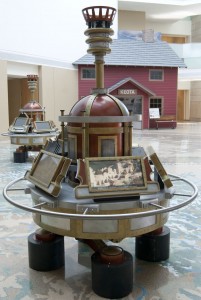Ever since Edward Snowden exposed the NSA’s efforts toward data collection, big data has become an idea that makes people nervous. Big data and personalization is often thought of as a corporate reach into the privacy of the consumer.
Kathleen Cohen, Digital Advisor and former VP of Digital Innovation and Integration for the National Constitution Center, spoke about the ethics of big data and personalization at the International Association of Amusement Parks and Attractions (IAAPA) panel “Future Legends of the Industry” at The Attractions Expo in Orlando last November. What became apparent to InPark Magazine was that the industry is lagging on this discussion. When Cohen asked who was talking about big data at their company, only two people raised their hands- Brian Edwards and Roberta Perry of ETI. We wanted to find out more.
Cohen is the lead consultant and founder of The Collaboratorium, Inc., a strategic, digital media consulting firm focusing on emerging technologies and the urban streetscape. Cohen also leads initiatives for persons with disabilities, focusing on accessibility & innovation, and user-experience. Cohen is particularly interested in how organizations lift the ceiling on human potential through innovative visitor experiences.
Previously, she worked at Walt Disney Parks and Resorts Online, IBM Centers for Innovation and DreamWorks Interactive. You can find out more about Kathleen at www.thecollaboratorium.com.

Big data: can you break it down for us?
With regard to theme parks and museums, I would boil big data down to this: it’s the by-product of the data we are collecting and analyzing in order to predict what our visitor wants and then, to give them options to act upon, based on the predictions. This is another way of saying that big data will give our visitors a valued, personalized experience and enhanced engagement that ideally would end in a feedback loop where we can even better know our visitor and tailor experiences for that person.
Big Data can be broken down into four steps:
1) Collection of Data: some you already have [CRM, POS, eCommerce, Social Media], others you have to purchase.
2) Descriptive Analytics: where you extract and condense the data from your visitor’s multiple access points into more useful sets of information (e.g., demographics, purchase history) so that you can describe what has happened, anywhere from “liking” in social media to a ticket purchase from five years ago.
3) Predictive Analytics: you take the data sets and crunch them even further through modeling, statistical and data-mining techniques to make a prediction of what might happen.
4) Prescriptive Analytics: where more than one prediction is made so that there are options/advice to offer, depending on the outcome so that the best course of action can be taken in alignment with your business goals. Essentially, you are curating a story about your visitor to align with your business goals.
What does personalization have to do with big data?
After working together with Brian Edwards from ETI on several personalized visitor experiences, it became clear through his thought leadership that if you are interested in what your institution will look like in the next five to ten years, personalization is essential. Without it on your business road map, your company could be at risk.
Now that most every visitor carries a mobile device, there are expectations that:
1) they can curate their own experience on their own device if a platform is not provided by the institution and
2) the environment will recognize them.
Given that mobile technology can find people or draw traffic to a brand (Presence Management), if the visitor opts in, the visitor will get a more enhanced, personalized experience available on the device. Theme parks and museums have an opportunity to deliver personalized content / experiences to the visitor. In order to do this, the theme park / museum needs to capture visitor information. Initially, the platform could be the personal mobile device, but eventually and ideally, it will be a wearable (e.g., Disney’s My Magic+ wristband) to get you away from being “heads down” in your personal device.
Can you provide an example of who is using big data for theme parks and museums in a successful way?
The biggest user by far is Disney and their MyMagic+ program. This program personalizes the guest experience at the theme parks and hotels in Orlando.
When I worked at Disney in 2000, they were already big data project planning, with the idea that it would be a twenty-year initiative. They had the foresight to invest in their guest because of their vision and leadership in customer relationship management.
But let’s first define success: I would say that since this is all so new and about moving the wheel, it’s more about the backend structure than the visitor experience for most companies at this point. Every ride, exhibit, interactive installation and show in development should consider having some big data built into its infrastructure.
The idea is to get everyone at the company to understand what your aims are and that there is a mantra of “doing no harm” to the customer. Are you committed to a deeper understanding and trusted relationship with your visitor?
From my experience, aiming the backend implementation of big data toward middle management usage means that everyone in your company can understand the overall mission of a big data strategy.
How do we even begin to collect, analyze and use big data?
Step 1) Determine, as an institution, if you use big data or if you’re going to be using it. (Of course, you should. Without it, your business will not be able to compete.)
Step 2) If yes, have you identified who in your organization is equipped to handle this? Many organizations think it’s the IT department, but this is not the way to go. It’s a joint conversation between digital (user experience designers, engineers) / marketing / visitor experience / executive. If you don’t have an in-house process for this, then there needs to be a big data strategy conversation.
Step 3) Hire a technology partner. This person / business will guide you through a big data process.
Step 4) Consider an ethical assessment, which takes into account two main principles of big data and personalization:
A) How do you have an enhanced personalized experience and “do no harm” to your visitor?
B) What are you prepared to give your visitor in exchange for his/her data?
“Doing no harm” means protecting your visitors’ data. This is a trust that your visitor has given you. By communicating your intentions, both internally and externally, with regard to big data and how you intend to use it, you can develop a competitive edge for your institution.
Step 5) If you agree in practice to steps 1-4, consider designing a small exhibit / interactive installation where you can get your feet wet with regard to big data.
So, if we initiate big data projects, what will be the benefit?
Big data is not going away and you will need to harness it in order to compete. Not only will you better understand your own needs and how to develop strategies within your own company, you will have a better understanding of new and existing visitors.
For example, when you talk about family entertainment, you’re talking about three generations – there’s a belief that the millennial generation would expect personalization and lead the family experience in the next five to ten years. You could build in repeatability, retention and loyalty as well as a feedback loop of when you need to update or change content.
For museums, which are dependent on grants and donations, being able to provide statistical information from big data is key. It reveals impact, ROI and helps to demonstrate being on mission. In addition, the way that museums have been traditionally built and curated is quickly becoming out-of-date and no longer dynamic for the visitor. The content has to be presented in a more appropriate way with regard to the digital world that we live in and the smart environments we engage in. This is vital for survival. If you are interested in more global information about where museums should be focusing their efforts, Arup F+R+I published, “Museums in The Digital Age” • • •







